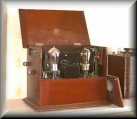|
NARRATIVE
A chain of events in a cause-effect relationship occurring in
time and space. A radio play narrative is made up of all the
events that we hear, plus all those that we infer or assume to
have occurred, arranged in their presumed causal relations, chronological
order, duration, frequency, and spatial locations.
Opposed to narration, which is the radio play's actual presentation
of certain events in the narrative.
NARRATION
The process through which a radio play conveys or withholds narrative
information, the way a story is told. Narration concerns the
actual arrangement and presentation of the story, the way in
which the radio play distributes story information in order to
achieve specific effects.
(RESEARCH)
CONTINUING THROUGH THE SITE: protagonist-dominated
===================================================================
Narrative
Deep structures
Definition of narrative and narrative deep structures
Narrative is the storyline in a play, the sequence of plot events.
There is usually the main plot and subplots. Narrative can be
set out in a "storyboard" of a play, as is used for
filming. It is both story and structure.
The study of narrative structure and story is narratology
or narrativity. These are the elements of storytelling, so important
for radio plays and its traditions. There is a pattern, or series
of interlocking patterns, or an architecture to a play narrative.
These are the deep structures of the play.
Discussion of narrative
It is useful to separate out the deep structures of a play from
the separate scenes and segments. It enables one to relate the
part to the whole. Another aspect of this three-dimensional view
is that one can analyse possible deep structure symbolism.
Dramatic narrative is cause and effect set in a temporal sequence:
beginning, middle and end. Narrative is to looked at both sequentially,
that is through the story, the sequencing itself, and also in
terms of the whole, the story itself.
The audience engages with, that is it reads, narrative simultaneously
at the levels both of structure and story content.
Discussion on narrative deep structures
There are a number of traditions of discussion in this area.
The Russian formalist tradition, especially Vladimir Propp, emphasised
simple narratives: folk tales, myths, thrillers. (Propp's work
was on Russian fairy tales which are not typical of modern narratives.)
Recent work has tended to investigate the complexity of structure.
German semiologists approached narrative as "text grammar",
attempting to extend the procedures of modern linguistics beyond
the sentence to the larger units of discourse. (See discourse
analysis for another applied approach in this textbook.)
Audiences read the narrative at the levels of structure and
story content. They anticipate its climaxes, recognise its pace
and closure. They follow its story or plot, see how it organises
the particular story elements as love, crime, horror. They see
how these have their points of origin in other stories, that
is genre, and in the real world, that is ideologies.
====================================
Quotes on narrative deep structures:
Steve Gooch , Writing a Play 79
The sense of one action following another like temporal building
blocks, of cause and effect, of logical
sequence ..
In order to convey an aspect of the inner life of a character
or describe an event in the past, the audience needs to know
about through a lengthy monologue or duologue, the dramatist
needs to have 'bought' the time that such a break in the forward
momentum of the play represents.
A tension needs to have been built up, a head of steam, so that
when it comes, the explanation of past events, inner feelings
or simple musing, is seen to have a cause, an urgency of its
own, and above all, is justified within the pressing demands
of the here and now. This comes to be increasingly relevant towards
the end of a play and is perhaps a measure of how successful
the dramatic impetus of the piece has built to the point where
it occurs.
=====================================
Bibliography on narrative deep structures
Seymour Chatman, Story and Discourse. Narrative structure in
fiction and film (Cornell 1978)
L Crawford, "Action nameability and filmic narrativity:
from inner speech to identification"
Quarterly Review of Film Studies 6 (1981) 265-
Jim Cook, "Narrative, comedy, character and performance"
in Television Sitcom (BFI Dossier 17) pp 13-.
Assignments on narrative and narrative deep structure
Make a storyboard of a radio play, preferably a thirty-minute
afternoon play.
Sketch a storyboard for a possible radio play, paying special
attention to the structures outlined in this section.
========================================
The study of narrative structures and the activity of narrative
comprehension is the subject of NARRATIVE ANALYSIS. Narrative
analysis focuses on the interaction of the various strata of
the narrative work, distinguishing such elements as story outline
and plot structure, the spheres of action commanded by different
characters, the way narrative information is channeled and controlled
through point?of?view, and the relationship of the narrator to
the inhabitants and events of the story?world.
The canonical versions of narrative analysis deal with the
structural characteristics or regularities that all narrative
forms have in common, regardless of medium. Narrative analysis
also specifies the ways in which actual narratives differ from
one another. The term NARRATOLOGY, introduced by Tzvetan Todorov,
has in recent years become the formal name for narrative analysis,
although for some writers it has a more specific meaning, relating
strictly to the structuralist study of narrative or to the subcategories
of tense, mood and voice (defined later in Part III). |




